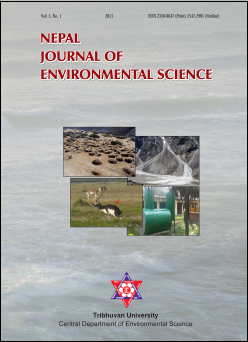Sustainability of rainwater harvesting system for the domestic needs: A case of Daugha Village Development Committee, Gulmi, Nepal
DOI:
https://doi.org/10.3126/njes.v5i0.22711Keywords:
Rainwater water harvesting, sustainability, multi-criteria methodAbstract
Rainwater Harvesting (RWH) system for the domestic needs in Daugha Village Development Committee (VDC), after its installation in 1996, has become a “unique water culture” with altogether 1,238 water harvesting jars and storage tanks of varied sizes at present in 663 households. The paper presents the sustainability of the RWH implemented 18 years back at the household level of Daugha VDC, Gulmi District. Various participatory tools like household interviews, key informant’s interviews and field observation along with water quality test of the stored water were carried out. The sustainability of the rainwater harvesting system was assessed based on the four key sustainability dimensions- Technical, Socio-environmental, Institutional and Cost recovery. The core factors and sub-factors were given weightage following the Multi Criteria Analysis (MCA) method. Daugha community has accepted RWH as an appropriate and effective alternative to meet the domestic water demand making the systems life savior, where water drudgery was at the peak and mostly women and children shared the responsibility of water management. On an average, 6.35 hours per family per day is saved because of installed RWH system in their homestead which is being utilized in some economic, social and child-care activities by the women. However, the best utilization of saved time for economic growth through various Income Generating Activities (IGAs) and mobilization of local funds to improve income level of the people seems lacking. Similarly, capacity and skills of local people to upgrade and improve their RWH systems have been observed as a gap. RWH systems have imparted very positive effect on sanitation and hygiene front. Significant progress was seen in terms of construction and use of toilets, increased knowledge about the importance of sanitation and hygiene issues, and changes in sanitation and hygiene behavior in the communities. This has resulted in decrease of water borne and water washed diseases recorded in the local sub-health post. These indicators portray the strong technical and socio-environmental acceptance of the system. In contrast to this, the study revealed that institutional and cost-recovery dimensions of sustainability are weaker, which pulls overall sustainability of RWH system under “sustained but at risk” when compared to sustainability ranking practiced by WaterAid.
Downloads
Downloads
Published
How to Cite
Issue
Section
License
This license enables reusers to distribute, remix, adapt, and build upon the material in any medium or format for noncommercial purposes only, and only so long as attribution is given to the creator.

